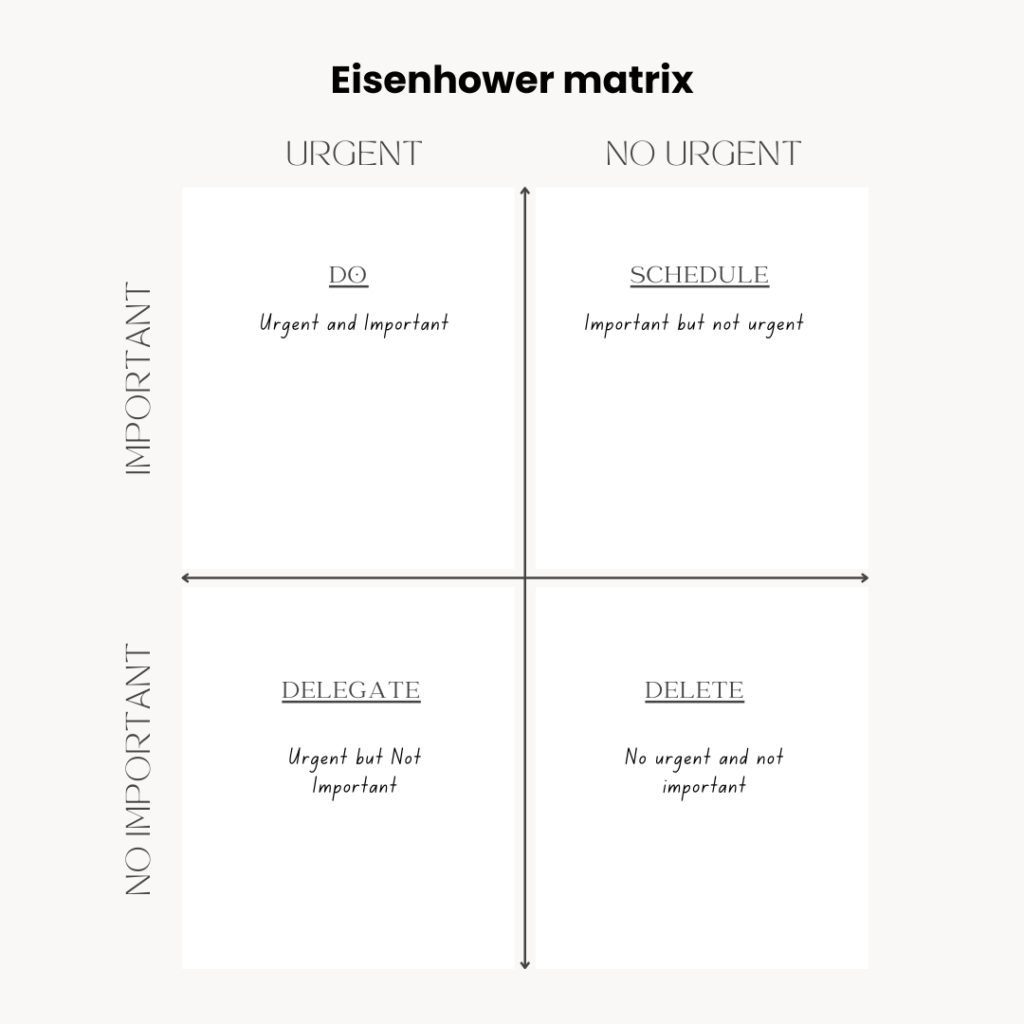Priorities are the tasks, activities, or objectives that hold the highest level of importance and urgency in our lives. Identifying and focusing on our priorities is essential for achieving our goals and managing our time effectively. Common priorities may include work or career goals, personal growth, family responsibilities, health and wellness, or financial objectives.

By clearly defining our priorities, we can allocate our time, energy, and resources more efficiently towards the areas that matter most. This helps us stay focused, avoid distractions, and make progress towards our desired outcomes. For example, if career advancement is a top priority, we may prioritize tasks related to professional development, networking, or taking on challenging projects that showcase our skills.
Establishing priorities also allows us to make informed decisions about how to spend our time. When faced with multiple demands or opportunities, we can evaluate them against our priorities and choose the options that align most closely with our goals and values.
Identifying Your Personal Values and Priorities
Understanding your core values is the foundation for setting meaningful priorities. Values represent what’s truly important to you – the principles and beliefs that guide your decisions and actions. Take time for self-reflection to uncover your key values, as described in this guide from MindTools. Once you’ve clarified your values, you can align your priorities with them.
Determine your long-term vision and life goals, as well as more immediate aims. Effective goal-setting requires being specific, measurable, achievable, relevant, and time-bound. Regularly revisit your goals to ensure your priorities continue serving your overall direction. As Mark Manson explains, there’s a difference between what we say we value and what we truly value based on our actions and where we allocate our resources like time and energy. Identify any gaps between your stated values and real priorities, and adjust accordingly.
The Eisenhower Matrix
The Eisenhower Matrix, also known as the Urgent-Important Matrix, is a powerful tool for prioritizing tasks and managing time effectively. Developed by former U.S. President Dwight D. Eisenhower, this matrix helps you differentiate between urgent and important tasks, allowing you to focus on what truly matters.
The matrix is divided into four quadrants:
- Urgent and Important: These tasks require immediate attention and are crucial to your goals or responsibilities. Examples include meeting critical deadlines, addressing emergencies, or dealing with high-priority projects.
- Important but Not Urgent: These tasks are essential but do not require immediate action. Examples include strategic planning, personal development, and long-term projects.
- Urgent but Not Important: These tasks are time-sensitive but not directly related to your goals or priorities. Examples include attending unnecessary meetings, responding to non-essential emails, or dealing with interruptions.
- Not Urgent and Not Important: These tasks are neither time-sensitive nor contribute significantly to your goals. Examples include mindless web browsing, excessive social media usage, or trivial activities.

The key to using the Eisenhower Matrix effectively is to focus your time and energy on the “Urgent and Important” quadrant, while also allocating time for “Important but Not Urgent” tasks. Tasks in the “Urgent but Not Important” quadrant should be minimized or delegated, and tasks in the “Not Urgent and Not Important” quadrant should be eliminated or minimized.
By applying the Eisenhower Matrix, you can prioritize your tasks based on their true importance and urgency, allowing you to work more efficiently and achieve your goals more effectively. [Source: Asana]
Time Management Techniques for Prioritization
Effective time management strategies can greatly aid in prioritizing tasks. The Pomodoro Technique involves working in focused 25-minute intervals followed by short breaks, allowing you to tackle important tasks without burnout. Time blocking involves dedicating specific time slots to high-priority tasks, ensuring they receive dedicated attention. The 80/20 rule suggests focusing on the 20% of tasks that yield 80% of the results, helping you prioritize high-impact activities.
Developing Habits and Routines
Establishing routines and positive habits is crucial for sticking to your priorities. Habits become ingrained behaviors that require less conscious effort, allowing you to focus on your goals without constant willpower drain. As Forbes suggests, leaders can use daily habits to better prioritize their time and energy.
Some tips for building positive habits include:
- Start small and build gradually
- Attach new habits to existing routines
- Make habits enjoyable or rewarding
- Track your progress and celebrate milestones
- Be patient and persistent; habits take time to form
By establishing routines around your priorities, you’ll find it easier to stay on track and make consistent progress towards your goals.
Prioritization Strategies for Work-Life Balance
Striking the right balance between work and personal life is a constant challenge in our fast-paced world. Prioritization is key to managing multiple responsibilities effectively. Begin by identifying your core values and goals, both professional and personal. This clarity will guide you in aligning your daily tasks with your long-term aspirations.
To prioritize work tasks, consider factors such as deadlines, impact, and effort required. Utilize tools like the Eisenhower Matrix or the ABCDE method to categorize tasks based on urgency and importance. Tackle high-priority tasks first, and learn to say no to non-essential commitments that may derail your focus.
In your personal life, prioritize self-care, relationships, and activities that bring you joy and fulfillment. Schedule quality time with loved ones, pursue hobbies, and engage in activities that rejuvenate your mind and body. Remember, a balanced life is not about dividing your time equally but about allocating it intentionally based on your priorities.
Embracing flexibility is also crucial. Priorities may shift depending on circumstances, so periodically reassess and adjust as needed. Communicate your boundaries and expectations with colleagues, family, and friends to manage their expectations and avoid conflicts.
Ultimately, prioritization is a continuous process that requires self-awareness, discipline, and a willingness to adapt. By aligning your actions with your values and priorities, you can achieve a greater sense of fulfillment and balance in both your professional and personal spheres.
Overcoming Obstacles to Prioritization
Identifying your priorities can be a challenging task, as it often involves overcoming various obstacles that can hinder your progress. One common obstacle is procrastination, which can stem from a lack of motivation, fear of failure, or simply feeling overwhelmed. To combat procrastination, it’s crucial to break down larger tasks into smaller, manageable steps and set realistic deadlines for each one. Additionally, eliminating distractions, such as social media or unnecessary notifications, can help you maintain focus and increase productivity.
Another obstacle that can prevent effective prioritization is the tendency to multitask. While multitasking may seem like an efficient way to accomplish multiple tasks simultaneously, research has shown that it can actually decrease productivity and increase the likelihood of making mistakes. Instead, it’s recommended to practice single-tasking, where you concentrate on one task at a time until completion.
To overcome these obstacles and maintain focus, consider implementing techniques such as the Pomodoro technique, which involves working in short, focused bursts followed by brief breaks. Additionally, creating a distraction-free environment, whether it’s a dedicated workspace or using noise-canceling headphones, can help you stay on track and avoid unnecessary interruptions.
Regularly Review and Adjust Priorities
Priorities are not set in stone; they are dynamic and subject to change based on various factors. It’s essential to regularly review and adjust your priorities to ensure they align with your current circumstances and goals. Life is unpredictable, and unexpected events or changes can occur, necessitating a reevaluation of what’s truly important.
As stated in an article from Economic Times, “Regular Review: Periodically review your priorities and adjust them as needed. As circumstances change, your priorities may also shift.” Regularly reviewing your priorities allows you to stay agile and adapt to new situations, ensuring that your time and energy are focused on the most pressing and relevant tasks.
When reviewing your priorities, consider any significant changes in your personal or professional life, such as a new job, a family addition, or a shift in long-term goals. Assess whether your current priorities still align with your overall objectives and make adjustments as necessary. Don’t be afraid to reprioritize or even eliminate tasks that no longer serve your goals or have become irrelevant.
Conclusion
Prioritization is a powerful tool for navigating the complexities of both personal and professional life. By clearly defining your values, setting achievable goals, and using effective time management techniques like the Eisenhower Matrix, you can focus on what truly matters. Developing positive habits and routines further supports your priorities, ensuring consistent progress toward your desired outcomes.
Remember, priorities are not static—they evolve with changing circumstances. Regularly reviewing and adjusting your priorities allows you to stay aligned with your goals, maintain balance, and overcome obstacles like procrastination. By embracing a flexible approach and staying true to your core values, you can create a fulfilling and balanced life that reflects what is most important to you.




